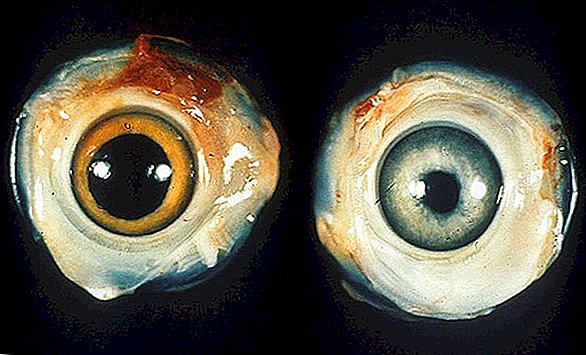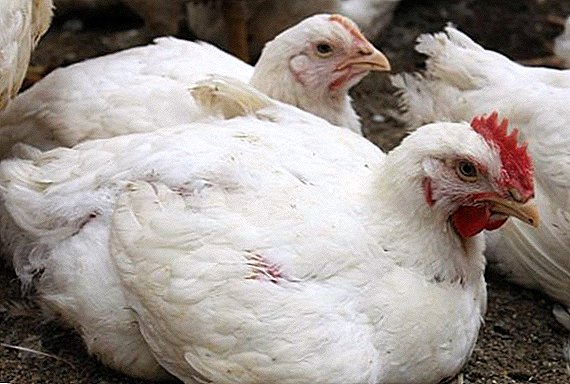 The broiler breed of chickens COBB 500 (COBB 500) is very common on domestic and foreign poultry farms due to the rapid set of muscle mass and at the same time low feed costs.
The broiler breed of chickens COBB 500 (COBB 500) is very common on domestic and foreign poultry farms due to the rapid set of muscle mass and at the same time low feed costs.
It is also often chosen for growing in small quantities in private farmsteads. But as you know, broilers have poor health and sensitivity to environmental conditions, so it is important to provide competent care to the bird.
Breed description
Broilers of breed KOBB 500 turned out as a result of crossing of Plymouth and Cornish chickens, as well as several outbred domestic Klush. Visually, these are powerful, large birds with a strongly developed muscular corset, a bulging chest, and strong legs. The plumage is snow-white in color, the comb and earrings are red, the beak, the paws and the body color are yellow.
Character
Broilers of this breed have a very calm character, phlegmatic in temperament. If you violate the conditions of detention can begin pecking or even cannibalism, but in general, such aggressive behavior is not typical for chickens.
Did you know? The UAE is the world leader in meat consumption per person per year. The country consumes up to 100 kg of product per capita.
Weight characteristics
The main advantage of the breed is the speed of gaining muscle mass and meat quality. With relatively low feed costs, chickens grow very quickly and at the age of 35-40 days can be sent for slaughter. Birds of this breed are characterized by very high uniformity of weight gain. That is, for the same time, chickens of the same age gain more or less the same weight, which is very important for revenue.  Growth kit chickens COBB 500 according to the standard:
Growth kit chickens COBB 500 according to the standard:
- newborns - 40 g;
- 7 days - 150-160 g;
- 2 weeks - 430 g;
- 1 month - 1350-1500 g;
- 1.5 months - 2800 g;
- 2 months - 3 or more kg.
Advantages and disadvantages
This breed is valued for the following qualities:
- rapid muscle growth, as a result, short feeding and low cost of cultivation;
- relatively strong immunity;
- readiness for slaughter at the age of 30 days;
- chick survival rate up to 97%;
- homogeneity of individuals of the same age;
- the possibility of breeding on large poultry farms and small farms.
Cross COBB 500 is included in the ranking of the best breeds of broilers.
This breed is not without its drawbacks. The downside is the impossibility of breeding broilers in the usual, traditional way. Incubated eggs or diurnal young should only be purchased from breeders. The fact is that being a cross breed of chickens, COBB 500 broilers are not able to pass on to the offspring characteristics obtained from the parent breeds as a result of crossing. In addition, the Klush has a very weak nasi instinct. Another disadvantage is the heat-loving nature of the breed, so in the process of growing a lot of resources go to maintain the desired temperature mode of the house.
In addition, the Klush has a very weak nasi instinct. Another disadvantage is the heat-loving nature of the breed, so in the process of growing a lot of resources go to maintain the desired temperature mode of the house.
We recommend to get acquainted with the features of the content of such broiler crosses: Cobb-700 and ROSS-308.
Breed content
Proper maintenance of birds will contribute to the development according to the rules, and will also help prevent many diseases.
Conditions of detention
It is strictly not allowed to contain broilers with the possibility of walking. Optimal floor or cellular content. In the first embodiment, the set of muscle mass is faster. On 1 square. m. allowed to place about 20 chicks or 10 grown up individuals.
Temperature conditions
The second most important condition for the correct content is the optimum temperature. Broilers require constantly high air temperature, do not tolerate hypothermia, a sharp temperature difference. It is also unacceptable to leave drafts in the house. In this case, the room must be equipped with a ventilation system to prevent staleness and dustiness.
The main purpose of broiler maintenance is to gain weight, so bird owners should know what to do if broilers do not gain weight.
Ideally, the temperature should be in the range of + 27-33 ° C. At low rates, chickens will bunch up, huddle near the heater. But the temperatures above the norm will not bring benefits either - the birds will lose their appetite, they will become apathetic. Electric heaters or infrared lamps can be used to heat the house.
Electric heaters or infrared lamps can be used to heat the house.
Light mode
From birth to 2 weeks of age, the lighting in the house should be around the clock. The fact is that at this time the bird actively consumes food, in the absence of light feeding is impossible, which as a result will have a negative impact on weight gain. After 14 days, you can gradually reduce the length of daylight hours, bringing it to 18 hours. It is advisable to use red lamps.
Important! Despite the high need of birds for lighting, the light should not be too bright. Bright lighting causes fear, anxiety, leads to rasklevu.
Nutrition
Food should be balanced and in sufficient quantity. Be sure to add to the diet of vitamin-mineral complexes. It is important to ensure that portions are constantly increasing in accordance with the growing needs of fast-growing birds. To avoid mistakes in the preparation of the diet and save time, you can buy ready-made high-quality compound feed, the composition of which is already selected for the needs of broiler breeds.  These feeds are divided into several groups for different ages of birds:
These feeds are divided into several groups for different ages of birds:
- "Prestart". From the first day of life for 5 days. Up to 15 g of feed is required per person per day.
- "Start". Used at the age of 6-18 days. Daily feed consumption is 25-90 g, depending on age.
- "Fattening". It is applied from 19 to 37 days. Daily consumption increases to 100-130 g.
- "The finish." From 38 days before slaughter. At this stage, the daily need for feed is 160-170 g.
For regulatory weight gain is to follow a strict feeding scheme. It is also necessary to provide constant access to clean, warm water. The number of feedings depends on age. In the first week, chickens are given food 8 times, then every week the number of feedings is halved, gradually bringing them up to 4 meals per day. This routine is maintained until slaughter.
Learn how to make feeders and drinkers for broilers with their own hands.
Cleanliness
Maintaining hygiene in the house is another prerequisite for keeping the bird. After the sale of a batch of broilers, the house must be thoroughly cleaned of litter, any litter, litter. Next, it is treated with disinfecting solutions and air, if necessary, whitewash.  The treatment of the premises can be carried out with such preparations:
The treatment of the premises can be carried out with such preparations:
- "Brovadez-plus". It can be used in the presence of birds. For preventive rehabilitation, a 0.25% solution is used, with infectious diseases, a 2-3% solution is used. Suitable for all surfaces in the house.
- "Viricide". It can be used in the presence of poultry in the house, safe for humans and birds, affects fungi, mold, pathogenic microorganisms and viruses. The drug is used to cleanse drinkers, feeders, cells.
- "Biodez-R". Destroys fungi, microorganisms. It can be applied in the presence of a bird in the room. For preventive treatment, a 1% solution is used, with fungal infections and tuberculosis, the concentration is increased to 2-4%.
You will probably find it helpful to know how to disinfect the hen house.
Diseases and control measures
Despite the relatively strong health, as for broiler breeds, health, a variety of COBB 500 may be subject to certain ailments. The main causes of diseases are deviations from the norms of housing and care, poor sanitation, poor quality of food and violation of the rules of feeding. It is necessary to assess the condition of the bird on a daily basis in order to calculate the weakened, lethargic clichés that fell to their feet. Possible breed diseases:
- Dyspepsia or indigestion. Newborns are very susceptible to this condition.
 Due to the weak and incompletely formed digestive system, as well as the absence of certain enzymes, they are unable to digest certain foods. To prevent the disease, it is necessary to carefully prepare the room before the arrival of day-old chicks, choose high-quality feeds, monitor the size of the pellets for newborns, and introduce fermented milk products into the diet.
Due to the weak and incompletely formed digestive system, as well as the absence of certain enzymes, they are unable to digest certain foods. To prevent the disease, it is necessary to carefully prepare the room before the arrival of day-old chicks, choose high-quality feeds, monitor the size of the pellets for newborns, and introduce fermented milk products into the diet. - Avitaminosis. It occurs as a result of a lack of nutrients in the feed. To prevent you need to follow the portions of food, when feeding with mash beans, it is necessary to introduce vitamin-mineral complexes.
- Marek's disease. A very dangerous infectious disease that affects the nervous system. It is not treated, because when diagnosing a bird is sent for slaughter and burned to prevent the spread of infection. Diseases are susceptible to adult broilers.
 On the left is a normal chicken eye. To the right is the chicken eye of a sick Marek's disease. To prevent the day-old chickens from being vaccinated, a thorough processing of the incubator eggs with formaldehyde is carried out, before placing a new batch of broilers, the chicken house must be treated with disinfectants.
On the left is a normal chicken eye. To the right is the chicken eye of a sick Marek's disease. To prevent the day-old chickens from being vaccinated, a thorough processing of the incubator eggs with formaldehyde is carried out, before placing a new batch of broilers, the chicken house must be treated with disinfectants. - Salmonellosis. It is a very dangerous disease, because when infected, all livestock is slaughtered without the possibility of using carcasses for food. The only effective preventive measures are: control of the quality of food and water, the purchase of incubator eggs and chickens only in proven poultry houses, and the maintenance of sanitary conditions. You can also use the vaccine, but it is only appropriate for farms in which cases of salmonellosis are frequent.
- Aspergillosis. Severe infectious respiratory fungal disease. Iodine preparations are used for the treatment. Since contaminated feeds become the cause of the disease, you need to carefully monitor the quality of the purchased products and follow the rules of storage.

- Pollurose. Bacterial infection affecting a bird of any age. In young animals it proceeds in an acute form. Infection usually occurs through infected feed. Antibiotic therapy (nitrofurans, cephalosporins, sulfonamides) is used to fight. Upon contact with a sick bird, it is important to consider that the disease is dangerous to humans.
- Bronchitis. A highly contagious airborne viral disease. Respiratory, nephrosonephritic syndromes, as well as damage to the reproductive organs may occur. It is very important to distinguish bronchitis from other bird diseases, as the clinical picture is blurred. When infected, the house is treated with disinfecting aerosols.
Important! After the previous batch of poultry and before the delivery of a new poultry house, it is necessary to process very well: throw out litter, carefully clean the litter. It is important to disinfect all surfaces in the room. Remember that such work should be carried out in protective clothing and respirator!
Broilers of the KOBB 500 breed have better health than their fellow tribesmen, so the cases of infection are quite rare with all the conditions of detention. The popularity of this breed is quite understandable - COBB 500 is profitable to grow on any scale. The demand for meat of this breed is very high, and together with high taste characteristics and unpretentiousness of the klush, the cultivation of these broilers becomes an almost win-win option.
Reviews




 Due to the weak and incompletely formed digestive system, as well as the absence of certain enzymes, they are unable to digest certain foods. To prevent the disease, it is necessary to carefully prepare the room before the arrival of day-old chicks, choose high-quality feeds, monitor the size of the pellets for newborns, and introduce fermented milk products into the diet.
Due to the weak and incompletely formed digestive system, as well as the absence of certain enzymes, they are unable to digest certain foods. To prevent the disease, it is necessary to carefully prepare the room before the arrival of day-old chicks, choose high-quality feeds, monitor the size of the pellets for newborns, and introduce fermented milk products into the diet. On the left is a normal chicken eye. To the right is the chicken eye of a sick Marek's disease. To prevent the day-old chickens from being vaccinated, a thorough processing of the incubator eggs with formaldehyde is carried out, before placing a new batch of broilers, the chicken house must be treated with disinfectants.
On the left is a normal chicken eye. To the right is the chicken eye of a sick Marek's disease. To prevent the day-old chickens from being vaccinated, a thorough processing of the incubator eggs with formaldehyde is carried out, before placing a new batch of broilers, the chicken house must be treated with disinfectants.










